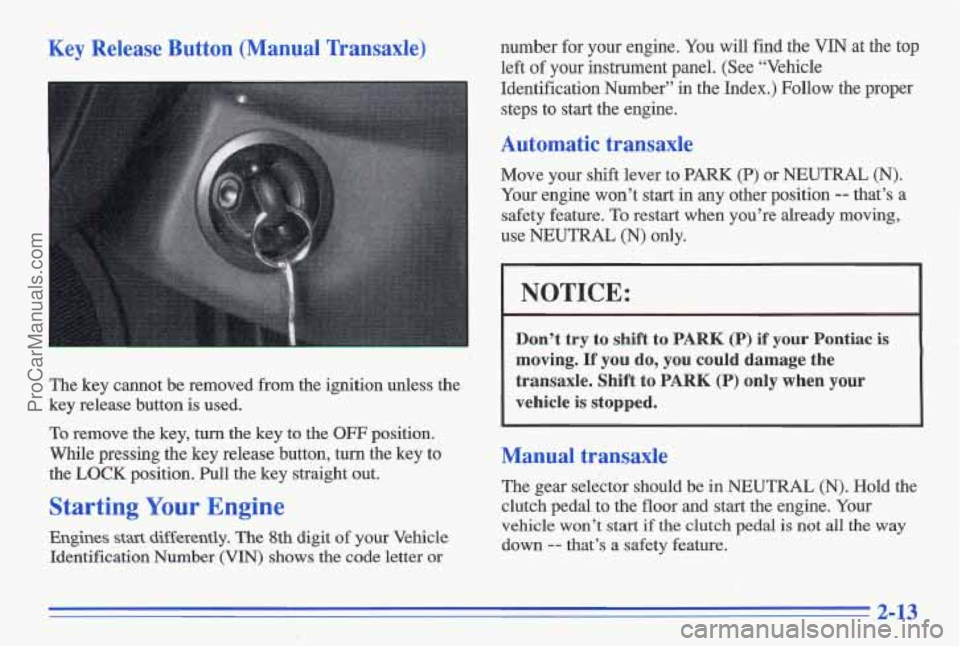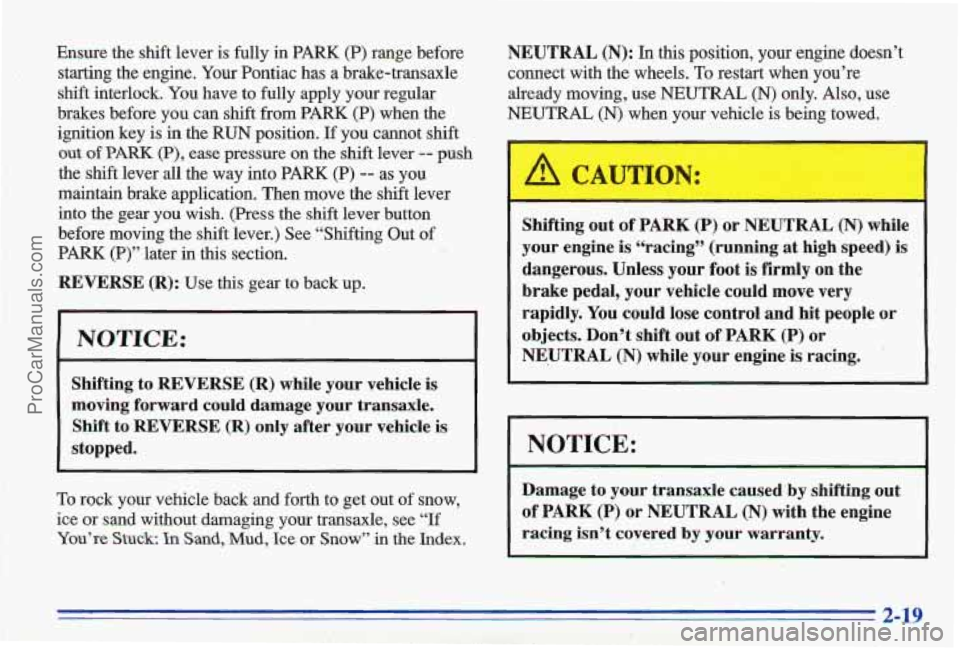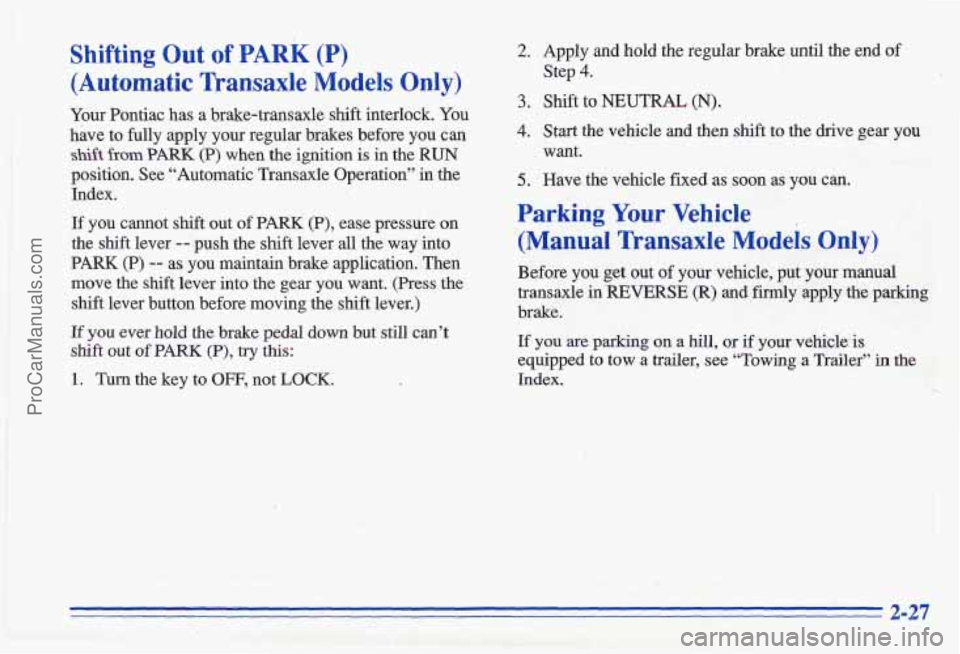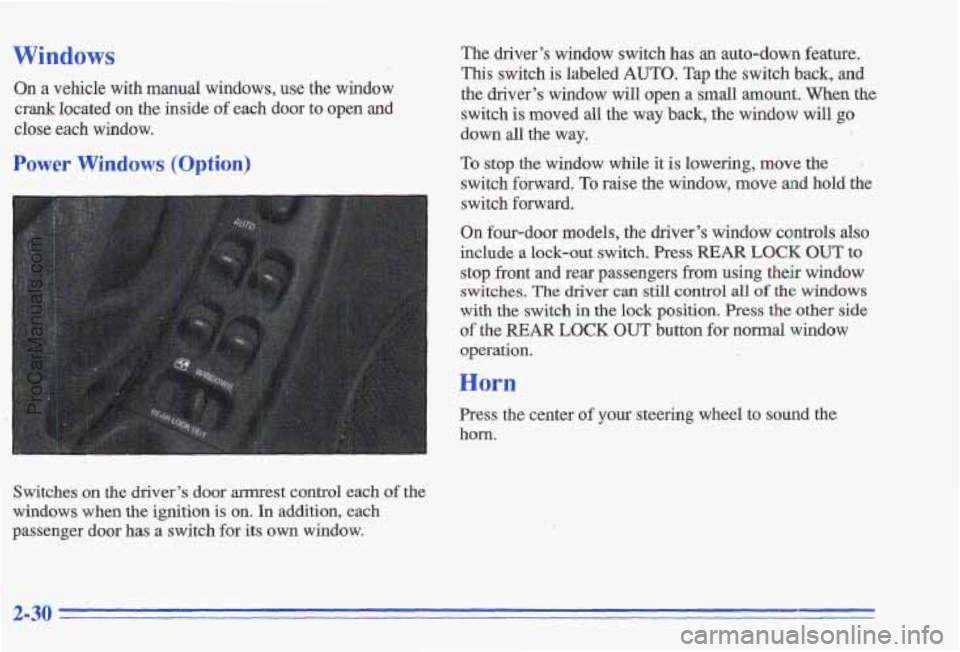Page 69 of 356

Key Release Button (Manual Transaxle)
The key cannot be removed from the ignition unless the
key release button is used.
To remove the key, turn the key to the
OFF position.
While pressing the key release button, tufn the key to
the
LOCK position. Pull the key straight out.
Starting Your Engine
Engines stast differently. The 8th digit of your Vehicle
Identification Number
(VIN) shows the code letter or number for your engine.
You will find
the VIN at the top
left of your instrument panel. (See “Vehicle
Identification Number” in the Index.) Follow the proper
steps to start the engine.
Automatic transaxle
Move your shift lever to PARK (P) or NEUTRAL (N).
Your engine won’t start in any other position
-- that’s a
safety feature. To restart when you’re already moving,
use NEUTRAL
(N) only.
NOTICE:
Don’t try to shift to PARK (P) if your Pontiac is
moving.
If you do, you could damage the
transaxle. Shift to
PARK (P) only when your
vehicle is
stopped.
Manual transaxle
The gear selector should be in NEUTRAL (N). Hold the
clutch pedal to the floor and start the engine. Your
vehicle won’t
stat? if the clutch pedal is not all the way
down
-- that’s a safety feature.
2-13
ProCarManuals.com
Page 70 of 356

Starting Your 2.4 Liter Engine
1. Without pushing the accelerator pedal, turn your
ignition key to
START. When the engine starts, let
go
of the key. The idle speed will go down as your
engine gets
warm.
NOTICE:
H’olding your key in START for longer than
15 seconds at a time will cause your battery to be
drained much sooner. And the excessive heat can
damage your starter motor.
2. If it doesn’t start right away, and if the weather is
very cold (below
-20°F or -29”C), push the
accelerator pedal about one-quarter of the way down
while
you turn the key to START. Do this until the
engine
starts. As soon as it does, let go of the key.
stops), it could be flooded with too much gasoline.
Try pushing your acc,elerator pedal all the way to the
3. If your engine still won’t start (or starts but then floor
and holding it there as you hold the key in
START for about three seconds. This clears the extra
gasoline
from the engine. If the vehcle starts briefly
but then
stops again, do the same thing, but this time
keep the pedal about one-quarter
of the way down
for five or
six seconds.
NOTICE:
Your engine is designed to work with the
electronics in your vehicle.
If you add electrical
parts or accessories,
you could change the way
the engine operates. Before adding electrical
equipment, check with your dealer.
If you don’t,
your engine might not perform properly.
If you ever have to have your vehicle towed, see
the part of this manual that tells how to do it
without damaging
your vehicle. See “Towing
Your Vehicle” in the Index.
2-14
ProCarManuals.com
Page 71 of 356

Starting Your 3.1 Liter Engine
1. Without pushing the accelerator pedal, turn your
ignition key to START. When the engine starts, let
go of the key. The idle speed will go down as your
engine gets warm.
NOTICE:
Holding your key in START for longer than
15 seconds at a time will cause your battery to be
drained much sooner. And the excessive heat can
damage your starter motor.
2. If your engine won’t start (or starts but then stops),
it could be flooded with too much gasoline.
Try
pushing your accelerator pedal all the way to the
floor and holding it there as you hold the key in
START for up to 15 seconds, This clears the extra
gasoline from the engine.
NOTICE:
Your engine is designed to work with the
electronics in your vehicle.
If you add electrical
parts or accessories, you could change the way
the engine operates. Before adding electrical
equipment, check with your dealer.
If you don’t,
your engine might not perform properly.
If you ever have to have your vehicle towed, see
the part of this manual that tells how to do it
without damaging your vehicle. See “Towing
Your Vehicle” in the Index.
ProCarManuals.com
Page 75 of 356

I
Ensure the shift lever is fully in PARK (P) range before
1 ’. I . starting the engine. Your Pontiac has a brake-transaxle !’ 2 . shift interlock. You have to fully apply your regular
brakes before you can shift from PARK (P) when the
ignition key is in the
RUN position. If you cannot shift
out of PARK (P), ease pressure on the shift lever -- push
the shift lever all the way into PARK
(P) -- as you
maintain brake application. Then move the shift lever
into the gear you wish. (Press the shift lever button
before moving the shift lever.) See “Shifting Out
of
PARK (I?)” later in this section.
REVERSE (R):
Use this gear to back up.
NOTICE:
Shifting to REVERSE (R) while your vehicle is
moving forward could damage
your transaxle.
Shift to REVERSE (R) only after your vehicle
is
stopped.
To rock your vehicle back and forth to get out of snow,
ice or sand without damaging your transaxle, see
“If
You’re Stuck: In Sand, Mud, Ice or Snow” in the Index. NEUTRAL
(N):
In this position, your engine doesn’t
connect with the wheels.
To restart when you’re
already moving, use
NEUTRAL (N) only. Also, use
NEUTRAL (N) when your vehicle is being towed.
I
Shifting out of PARK (P) or NEUTRAL (N) while
your engine
is “racing” (running at high speed) is
dangerous. Unless your foot is firmly on. the
brake pedal, your vehicle could move very
rapidly.
You could lose control and hit people or
objects. Don’t shift out of PARK
(P) or
NEUTRAL
(N) while your engine is racing. .
NOTICE:
Damage to your transaxle caused’by shifting ‘out
of PARK
(P) or NEUTRAL (N) with the engine
racing isn’t covered
by your warranty.
ProCarManuals.com
Page 80 of 356
Parkiaag.’Brake handle. If the ignition is on, the brake system warning
light will come on.
To release the parking brake hold the regular brake
pedal down. Pull
the parking brake lever up until you
can press the release button. Hold the release button in
as you move the brake lever all the way down.
Driving with the parking, brake on can cause
your rear brakes to overheat. You may have to
replace them, and you could also damage other
To set the parking brake hold the .regular brake pedal If you are towing a trailer and are parking on my hill,
see “Towing
a Trailer” in the Index. That section shows
down with Your ‘ght foot* On the parking brake what to do first to keep the bailer from moving.
2-24
ProCarManuals.com
Page 81 of 356
Shifting Into PARK (P)
(Automatic Transaxle Models Only)
It can be dangerous to get out of your vehicle if
the shift lever
is not fully in PARK (P) with the
parking brake firmly
set. Your vehicle can roll.
If you have left the engine running, the vehicle
can move suddenly.
You or others could be
injured.
To be sure your vehicle won’t move, even
when you’re on fairly level ground, use the steps
that
follow. If you’re pulling a trailer, see
YI‘owing
a Trailer” in the Index.
2. Hold the brake pedal down with your right foot and
set the parking brake.
2. Move the shift lever into PARK (P) position‘like
this:
Hold in the button on the lever.
0 Push the lever all the way toward the front of
your vehicle.
3. Move the ignition key to LOCK.
4. Remove the key and take it with you. If you can
leave your vehicle yith the ignition key in your
hand, your vehicle is in PARK (P)
2-25
ProCarManuals.com
Page 83 of 356

Shifting Out of PARK (P)
(Automatic Transaxle Models Only)
Your Pontiac has a brake-transaxle shift interlock. You
have to fully apply your regular brakes before you can
shift from PARK (P) when the ignition is in the RUN
position. See “Automatic-Transaxle Operation” in the
Index.
If you cannot shift out of
PARK (P), ease pressure wn
the shift lever -- push the shift lever all the way into
PARK (P)
-- as you maintain brake application. Then
move the shift lever into the gear you want. (Press the
shift lever button before moving the shift lever.)
If you ever hold the brake pedal down but still can’t
shift
out of PARK (P), try this:
1. Turn the key to OFF, not LOCK. , ,<. j:~+!-,. , , ‘(, . .I. ”
,..I_ . , , . P ., , :. a -9 -- ....,. 4 -’. .:‘.I..: .,:- ;.
i.. ’ .--4 ..
2.
3.
4.
5.
Apply and hold the regular brake until the end of
Step
4.
Shift to NEUTRAL (N).
Start the vehicle and then shift to the drive gear you
want.
Have the vehicle fixed
as soon as you can.
Parking Your Vehicle
(Manual Transaxle Models Only)
Before you get out of your vehicle, put your manual
transaxle in’REVERSE
(R) and firmly apply the-parking
brake.
If you are parking on a hill, or if your vehic1e.k
equipped to tow
a trailer, see “Towing a Trailer” in the
Index.
ProCarManuals.com
Page 86 of 356

Windows
On a vehicle with manual windows, use the window
crank located on the inside of each door to open and
close each window.
Power Windows (Option)
Switches on the driver’s door armrest control each of the
windows when the ignition is on.
In addition, each
passenger door has a switch for its own window. The driver’s window switch has
an auto-down feature.
This switch
is labeled AUTO. Tap the switch back, and
the driver’s window will open a
small amount. When the
switch is moved all the way back, the window will go
down all the way.
To stop the window while it is lowering, move the .
switch forward. To raise the window, move and hold the
switch forward.
On four-door models, the driver’s window controls also
include a lock-out switch.
Press REAR LOCK OUT to
stop front and rear passengers from using their window switches.
The driver can still control all of the windows
with the switch in the lock position. Press the other side
of the
REAR LOCK OUT button for normal window
operation.
--
Horn
Press the center of your steering wheel to sound the
horn.
2-30
ProCarManuals.com